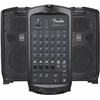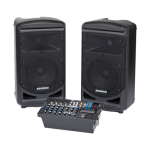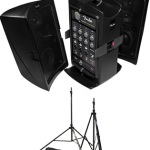
The proper sound system can critically impact student performance in your classroom.
Classroom sound systems include any sound reinforcement system that amplifies a teacher’s voice to reach all corners of the classroom, overcoming background noise and enhancing student concentration.
A portable classroom sound system provides an affordable solution for teachers seeking a simple-to-use system that’s easy to carry from place to place.
But before you choose a portable sound system for your classroom, ask yourself these 6 questions:
1. How portable should your classroom sound system be?
If you want to use your sound system in different classrooms throughout the school, but don’t need a lot of power, consider a mini PA system.
These highly portable PAs are ideal for teachers who want a personal sound system that they can carry from class to class.
This solution is only practical for smaller rooms, however. Larger rooms and halls will require more power, and therefore a bigger sound system.
If that’s your preference, then look for a portable PA system designed to cover rooms of 100 students or more. Such systems should not only be easy to move but also easy to set up and repack.
To achieve the ultimate in portability consider getting a sound system with batteries. Remember to consider how long you’ll need the battery to last (and how long it takes to recharge). Such battery operated sound systems are suitable for use on field trips or other on-the-go activities.
2. What kind of microphone should you use for your portable classroom sound system?
Most portable classroom sound systems are compatible with a variety of microphones.
Some of the less expensive PA systems have built-in microphones which are adequate for recording or sound projection in small areas.
Wired handheld microphones are the most common and usually are the default in any PA system which you purchase off the shelf.
Wireless microphone systems — especially hands-free wireless microphone systems like lavaliere (or lapel) microphones — eliminate cumbersome cords and allow greater freedom of motion for a teacher. Hands-free microphones are also available as collar microphones, and microphones that mount on headbands or headsets.
When choosing a wireless microphone for your classroom sound system, an important consideration is interference — particularly radio interference, as most portable systems use FM UHF or VHF wireless technology.
As an example, multiple FM wireless systems in the same school may compete with one another. In these situations, you may need a wireless FM system with switchable frequencies so teachers can select interference-free channels.

3. How much power do you need for your classroom sound system?
It’s important to properly gauge your power requirements because sound systems become heavier as they increase in wattage.
One of the key principles of PA system selection is the larger the classroom, the more watts you’ll need.
A mini PA system with 5 watts of power, for example, may be adequate for a small classroom. For a classroom seating 50 to 75 students, however, you might want to consider a portable sound system with up to 50 watts of power.
For large lecture halls and auditoriums, a portable large area sound reinforcement system is available — but in many cases, it’s better to opt for an installed system in such venues.
4. Will you be using the sound system in your classroom for speech or for music?
Music requires greater fidelity than speech, and therefore requires more power.
If you won’t use your portable sound system to reproduce music, and your classroom is small, a mini PA should be adequate.
Most inexpensive mini PA systems, however, are not made to reproduce the high and low frequencies that are intrinsic to experiencing music — even in a relatively small classroom.
Many mid-size portable sound systems feature loudspeakers and amplifiers designed to provide the frequency response necessary for quality music reproduction.
5. Is the classroom going to be used for formal and/or prestigious presentations?
A demonstration that involves frequent trips to the blackboard may be well served by a small portable speaker placed on a desk, but formal lectures require a system that complements the prestige of the presenter.
Portable tabletop lectern PA systems add authority by providing a platform for notes and readings. Such powered lecterns include built-in loudspeakers and amplifiers. Many offer optional remote speakers as well.
In general, choosing a tabletop lectern to fit your needs involves many of the same factors — including portability and power — as picking any sound system for your classroom.
Lecterns come with a variety of features. Some have inputs for additional microphones, some include wireless microphone systems and still others include audio inputs to attach existing classroom media players such as cassette players and recorders, or multimedia boomboxes.

6. What other features do you need to conduct your class?
Consider the needs of your style of teaching and what your lesson requires.
For example, if your curriculum includes pre-recorded audio such as music or narrated text, you may want a sound system with a built-in cassette or CD player. If you already have a media player, consider a sound system with extra inputs to accommodate audio from external sources.
When shopping for features, remember that as you add more features, you’re adding to the price tag. Figure out which options you can’t live without and which ones you can sacrifice for the sake of saving money, to get the system that does what you want at a good price.
Still have questions? Expert advice from the AudioLink staff is just a phone call (407-757-3326) or email away!


